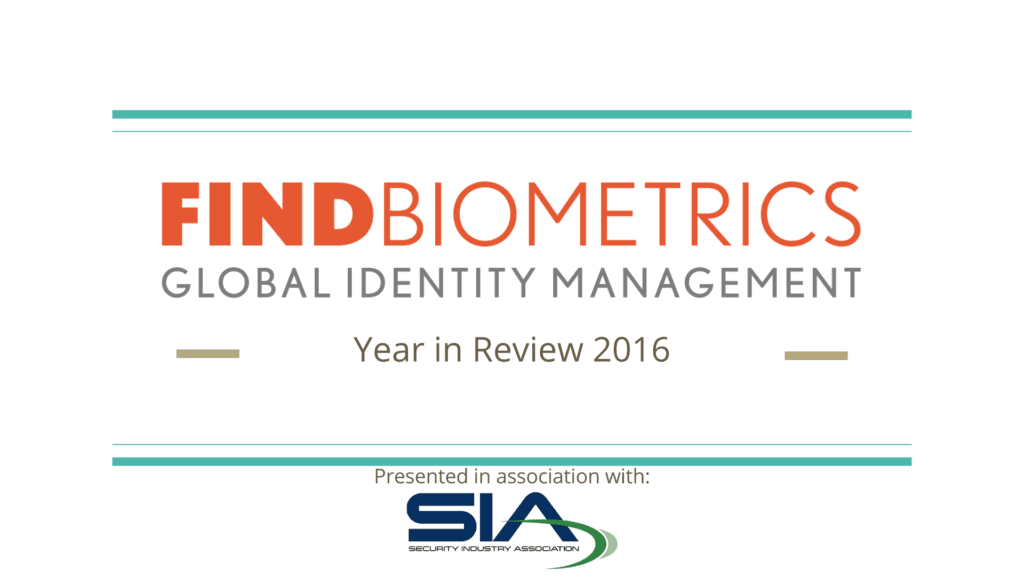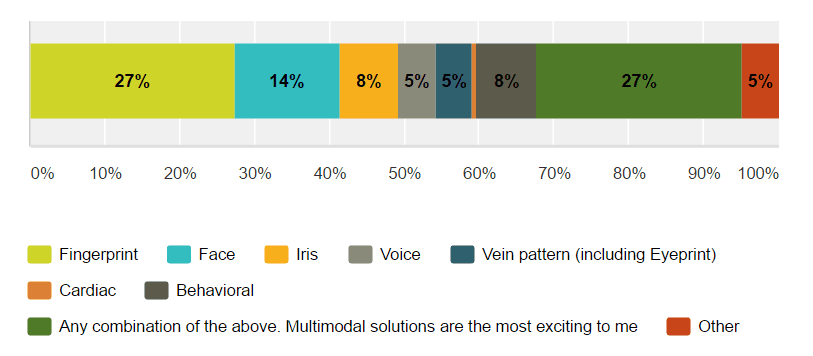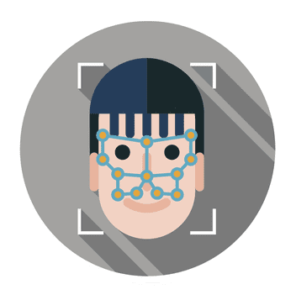In December we polled 165 professionals in biometrics and identity related industries about various topics from the past year. It was part of the FindBiometrics Year in Review, the longest-running and best regarded industry retrospective of its kind. Now in its 14th consecutive year, the FindBiometrics Year in Review is your resource to start 2017 off with your fingers on the pulse of biometrics and global identity management.
Earlier this week we examined some of that factors that lead to 2016 being the first year biometrics truly felt like a mainstream technology. Now, it’s time to look a little deeper into that assertion, and examine what the most popular and exciting modalities were in 2016.
We asked our survey respondents to tell us what they thought was the most exciting modality of the year. Here is a look at their responses:

Fingerprint and Multimodal
 In first place for most exciting biometric modality we had our first ever tie. Fingerprints and multimodal biometric authentication shared the spotlight. This probably won’t come as the biggest surprise—fingerprint sensors have been subject to massive mobile device proliferation and have also seen very fast, very notable evolution over the past 12 months. Meanwhile there has been a shift in demand towards multimodal solutions from service providers looking to offer clients choice over authentication method.
In first place for most exciting biometric modality we had our first ever tie. Fingerprints and multimodal biometric authentication shared the spotlight. This probably won’t come as the biggest surprise—fingerprint sensors have been subject to massive mobile device proliferation and have also seen very fast, very notable evolution over the past 12 months. Meanwhile there has been a shift in demand towards multimodal solutions from service providers looking to offer clients choice over authentication method.
Fingerprint biometrics have long been the poster-child for the identity management industry, and this is the third year in a row that the modality has topped our audience’s list of most exciting modalities. In terms of fingerprints, 2016 stood out for a number of reasons. In the realm of consumer biometrics, the modality was integrated to near-ubiquity on smartphones of all price ranges, it started to proliferate the notebook market, and USB peripherals like those offered by BIO-key enabled users to add fingerprint authentication to PCs, tablets, and laptops that lack the sensors. Fingerprints were also the subject of controversy in the ongoing conflict between ride sharing companies and public safety advocates concerning biometrics-based background checks, and sensor manufacturers made moves to capitalize on the smart cards market while also launching under-glass fingerprint sensors. As has come to be expected year after year, 2016 was an exciting time for fingerprints.
Multimodal biometrics saw a surge in popularity over 2015, when it came in with the third most votes. The popularity of multimodality was apparent throughout the year on many fronts. Early on we saw financial services providers like Visa show enthusiasm towards providing users a choice on how to authenticate—an enthusiasm that saw Visa patterning with the likes of Safran Identity & Security, BioConnect, and other biometrics companies throughout the year. But beyond the convenience and accessibility, multimodal solutions can often also mean multi-factor, which in turn equates to better security. In 2016 the password continued to fail us as a security solution, with some of history’s greatest security breaches emphasizing just how important it is to have strong authentication solutions. Multi-factor biometric technology become an important part of the discussion in 2016 because of how simply it can exponentially improve security. Face and voice were the most common bedfellows in this sense, often combined in software solutions like Mastercard Identity Check, but with the advent of iris scanning smartphones some industry experts have been championing the eye-and-finger combination.
Facial Recognition
 Facial recognition came in second place this year with our survey respondents, just as it did last year. In addition to the multimodal deployments mentioned above, face biometrics seemed to outgrow a lot of the controversy that plagued it in recent history. A big part of this maturity in the eyes of the public may have come from an increased familiarity through exposure to the technology, but also from a shift in branding when it comes to mobile facial recognition. In 2016 it became very common to see mobile facial recognition branded as Selfie authentication—a trend that not only perfectly explains the authentication process, but makes it familiar and safe. As a contactless modality, facial recognition has also found itself in ongoing conversations of social media, machine learning, Smart Cities, and the Internet of Things, aspects of the industry that are sure to keep the modality exciting through 2017.
Facial recognition came in second place this year with our survey respondents, just as it did last year. In addition to the multimodal deployments mentioned above, face biometrics seemed to outgrow a lot of the controversy that plagued it in recent history. A big part of this maturity in the eyes of the public may have come from an increased familiarity through exposure to the technology, but also from a shift in branding when it comes to mobile facial recognition. In 2016 it became very common to see mobile facial recognition branded as Selfie authentication—a trend that not only perfectly explains the authentication process, but makes it familiar and safe. As a contactless modality, facial recognition has also found itself in ongoing conversations of social media, machine learning, Smart Cities, and the Internet of Things, aspects of the industry that are sure to keep the modality exciting through 2017.
Iris Recognition and Behavioral Biometrics
 In third place we have another tie: iris biometrics and behavioral biometrics. Iris recognition almost took the mainstream consumer world by storm with a high profile integration on the Samsung Galaxy Note7—a development that had the modality paired as an authentication factor of the Samsung Pay mPayment platform. Sadly, the handset was fatally flawed, and in the span of months was fully recalled and deactivated. Outside of the consumer mobile space, however, iris continued to find deployment throughout the world in national ID and physical access capacities. With the groundwork laid for mainstream adoption, maybe 2017 will see it integrated onto a less explosive top tier handset, where it can really jump into the limelight.
In third place we have another tie: iris biometrics and behavioral biometrics. Iris recognition almost took the mainstream consumer world by storm with a high profile integration on the Samsung Galaxy Note7—a development that had the modality paired as an authentication factor of the Samsung Pay mPayment platform. Sadly, the handset was fatally flawed, and in the span of months was fully recalled and deactivated. Outside of the consumer mobile space, however, iris continued to find deployment throughout the world in national ID and physical access capacities. With the groundwork laid for mainstream adoption, maybe 2017 will see it integrated onto a less explosive top tier handset, where it can really jump into the limelight.
It was an exciting year for behavioral biometrics, too. Banks from around the world have been testing behavioral platforms for anti-fraud purposes, and in 2016 we saw expansions of such deployments (as in the case with NatWest’s expansion of BioCatch technology). We also saw the modality evolve beyond human-verification applications and into the realm of password replacement. Near the end of 2016, Leumi Card was reported to be testing our behavioral biometrics from SecuredTouch as a passive authentication method. Moving forward in 2017, it will be interesting to see what’s next for this exciting and nuanced biometric modality.
*
Stay posted to FindBiometrics throughout January as we continue to breakdown our Year in Review 2016 results.
The FindBiometrics Year in Review is presented in association with SIA and made possible by our sponsor: Tascent


Follow Us